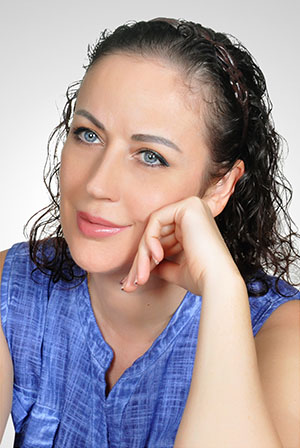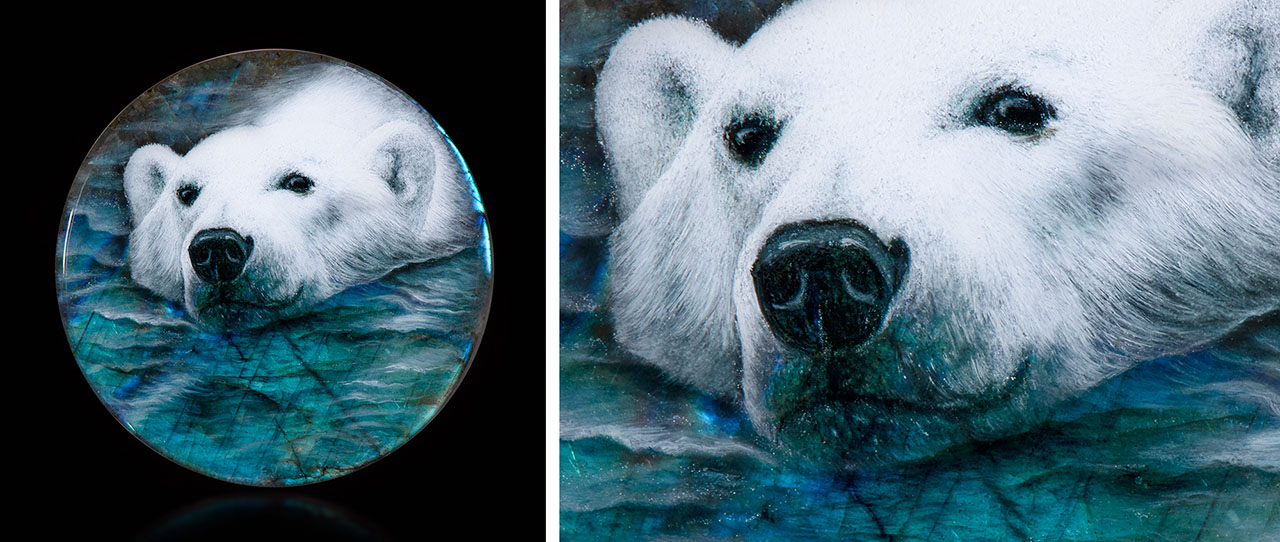Dance of Light and Color: Painted Labradorite

Valentina Fetisova’s improbable path from trained ballerina to painter of gem labradorite has two common denominators: love of art and an unwavering dedication to the tiniest detail.
Born in Obninsk, Russia, Fetisova was enamored with ballet from the age of eight months, when she would stand in front of her mother’s television, transfixed by the performance on screen. She went on to dedicate 24 years of her life to dance under the direction of ballet greats Gediminas Taranda and Maya Plisetskaya. Fetisova eventually fulfilled a childhood dream to tour with the Imperial Russian Ballet. Seven years into professional ballet, however, she decided it was time for a change.
FROM FINGERNAILS TO STONE
After leaving ballet, Fetisova launched a new career as a nail artist. “I wanted each tiny painting to look like a work of art,” she says. After taking dozens of courses on painting and scouring the Internet for ideas and techniques, she eventually came upon the concept of painting on stones. She searched for a mentor who could teach her this art and found two master painters who agreed to give her private lessons—the second one for only two days. “The second master was invaluable for me because the man is a genius and was able to share so much,” Fetisova says. In total, she has been painting for close to 20 years. “What I learned could have graduated me from the university!” she says.
“I painted my first panther on labradorite, and everyone who saw it loved it. It became my calling card. It somehow happened that more and more labradorites soon fell into my hands, and I boldly began to paint on them, too. I brought out my technique of painting on glowing stones; it is more complicated and time-consuming, but now you can evaluate the result yourself.” (See video above to view how the labradorescence phenomenon changes with the tilt of the stone.)
Fetisova, who left Russia in 2009 and now lives in Antalya, Turkey, has developed a technique that takes advantage of the glowing colors of the gem’s labradorescence, particularly as a stone is tilted in relation to a light source, to give her paintings a dramatic effect. She enjoys watching people pick out a favorite painted labradorite from her collection, which includes beautiful landscapes, people, wildlife, flowers, and even science fiction scenes.
“Though it was not my goal to paint space items or fantastic stories—those pieces were ordered specially—they did turn out well, so I’ll continue to paint them.” For customers who aren’t sure what they want, she refers to the “magic” of the stone. “A person is attracted to one, takes it in their hands, and no longer needs to see any other stones. The stone and its new owner have found each other.” Her clientele includes members of royal families (she’s not disclosing who) and notable jewelers.
TECHNIQUE
Fetisova says that most of her “canvases” come to her as prepolished cabochons. The first step is to remove the polished surface through sanding with emery paper and other abrasives. To protect her intellectual property, Fetisova does not disclose the grit or brand of varnish or paint. However, she notes that a miniature image of her subject matter is then transferred onto the gem’s sanded surface with tracing paper. After this step, a series of color spots are painted onto the surface, and the stone is placed in an oven to dry at a temperature not exceeding 70°C (158°F). This is followed by a layer of varnish and a drying phase. She mattes this surface again with sandpaper and paints a second layer onto the stone, to be dried again. “The transparency of the paint on the surface makes it possible to create different shadow effects and at the same time control the transparency of the image, especially on shiny stones.”
Fetisova explains that the clarity and beauty of each painting evolves from layer to layer and through successive steps in the drying process. The number of layers can vary, but in most cases she can complete her painting in about four layers. Once the work is finished, she paints the date and her signature on the back of the gem. She then varnishes the stone again in several layers, on both sides.
Then it is time to evaluate her work. If Fetisova likes what she sees, the piece is finished and ready for sale and, ultimately, for a little “magic” with a buyer.
PHOTO GALLERY
Fetisova makes use of the gems’ labradorescence to add drama and color to her paintings. The effect is best captured as the photographer angles the light or the gem to exhibit this phenomenon. We would like to acknowledge Mike Bowers for bringing Fetisova’s work to our attention and for generously allowing us to photograph his collection of her paintings on labradorite.













